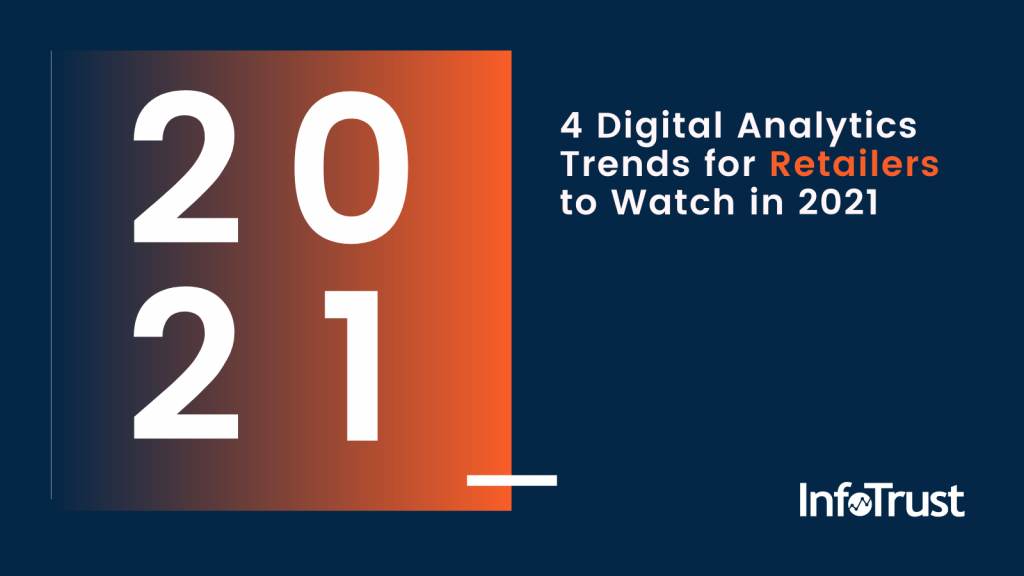The world-changing events of 2020 impacted nearly every industry, with retail and eCommerce seeing dramatic shifts in consumer behavior. While the COVID-19 pandemic is still far from over, many lessons have already been learned by retail marketers and analytics professionals that can lead to business-changing moves now.
At InfoTrust, our team specializes in digital analytics and consumer data governance for retail, eCommerce, and direct-to-consumer companies. In this article, we outline some key industry trends our clients are seeing in early 2021; by taking note now, you can position your company for whatever may come next in the world or retail.
1. Unifying Online and Offline Data
With today’s uncertainty, retailers with storefronts often find it difficult to predict foot traffic—and in turn, sales. Looking at your web traffic to get a read on the state of your business only tells a partial picture. To better understand how your entire sales ecosystem is performing, unifying online and offline data is crucial.
Many leading retailers are implementing a “buy online pickup in store,” or “BOPIS,” experience for consumers and expect this to continue into 2021. In fact, some predictions indicate as much as 90% of retailers will implement a BOPIS experience by the end of the year.
Having offline and online data integrated, as well as a digital BOPIS experience, allows retail organizations to unlock a complete understanding of your company’s sales and how your customers are purchasing.
2. Truly Understanding Your Users
Protecting user privacy will continue to be a trend in 2021, and with the introduction of Google Analytics 4—an event-based data model—the emphasis for analysts will now be on understanding users holistically, outside of individual sessions. In fact, continuing to have a session focus can actually limit your understanding of how your users are purchasing or interacting on your digital properties. By looking at digital behavior on the user level, you give more consideration to micro actions—such as adding an item to a favorites list—that can actually have a major impact.
This becomes even more effective when you unify your data, this time on the user level. By joining all of your various user IDs internally (and in a compliant manner), you can glean holistic insight into who your customers (both current and prospective) are—from the ads they’re served to their digital behaviors to the products they purchase. Your marketing dollars can become more efficient, optimizations more accurate, and tailored communications more effective.
3. Maximizing Efficiencies
Gains in efficiency can help rectify unpredictability, which is inevitable in 2021. Luckily, we have plenty of technology to lean on to help make improvements.
- A/B testing: By streamlining your current site experience, you’ll be able to get more conversions from your same level of traffic. This can help your current acquisition efforts work smarter and drive more results. You can also play with testing personalization for different groups of users to enhance their on-site experience and drive conversion.
- Leveraging everything in your current tech stack: Make sure that you’re taking advantage of all out-of-the-box features you’re paying for! If you have Google Analytics 360, you have access to more advanced attribution, the capability to build custom funnels, the ability to link to other data systems, and so much more. Take advantage of what is already in your arsenal. If you need help, we are here for you. [Editor’s note: Check out our guide on “Doing More with Less” from Chief Growth Officer Michael Loban.]
- Automation: Anytime you can automate processes or tasks, you save time—which you can then spend focusing on other initiatives. A useful task that you can automate is tag management; save time by setting up custom alerts when tags are added, removed, or modified on your site. [Editor’s note: Check out Tag Inspector if you’re in need of a tag auditing tool with these features.] If you use BigQuery, you can also leverage machine learning to optimize your paths to conversion on your site in an automated way.
4. Building Out Reporting Capabilities
All of the above trends are dependent on good measures of success, which leads to our final trend of 2021: building out reporting capabilities.
In these crazy times it’s imperative to monitor what’s happening in your business, and if you do make any changes on conservative budgets, being able to show that those changes worked (or didn’t) is critical. Whether you’re building reporting in your digital analytics tool or integrating with other sources in your organization, it’s important to have a clear set of KPIs and to build reporting functionalities to showcase those KPIs. Make all necessary dashboards accessible to everyone who needs them, giving stakeholders what they need to succeed. Your organization will then truly be ready to recognize and take on any challenge that comes its way.
While 2021 may seem very uncertain (and a bit overwhelming), acting on any or all of the above retail industry digital trends will hopefully bring you and your organization some short- and long-term peace of mind. If you have questions, don’t hesitate to contact the retail digital analytics consulting team at InfoTrust today.


